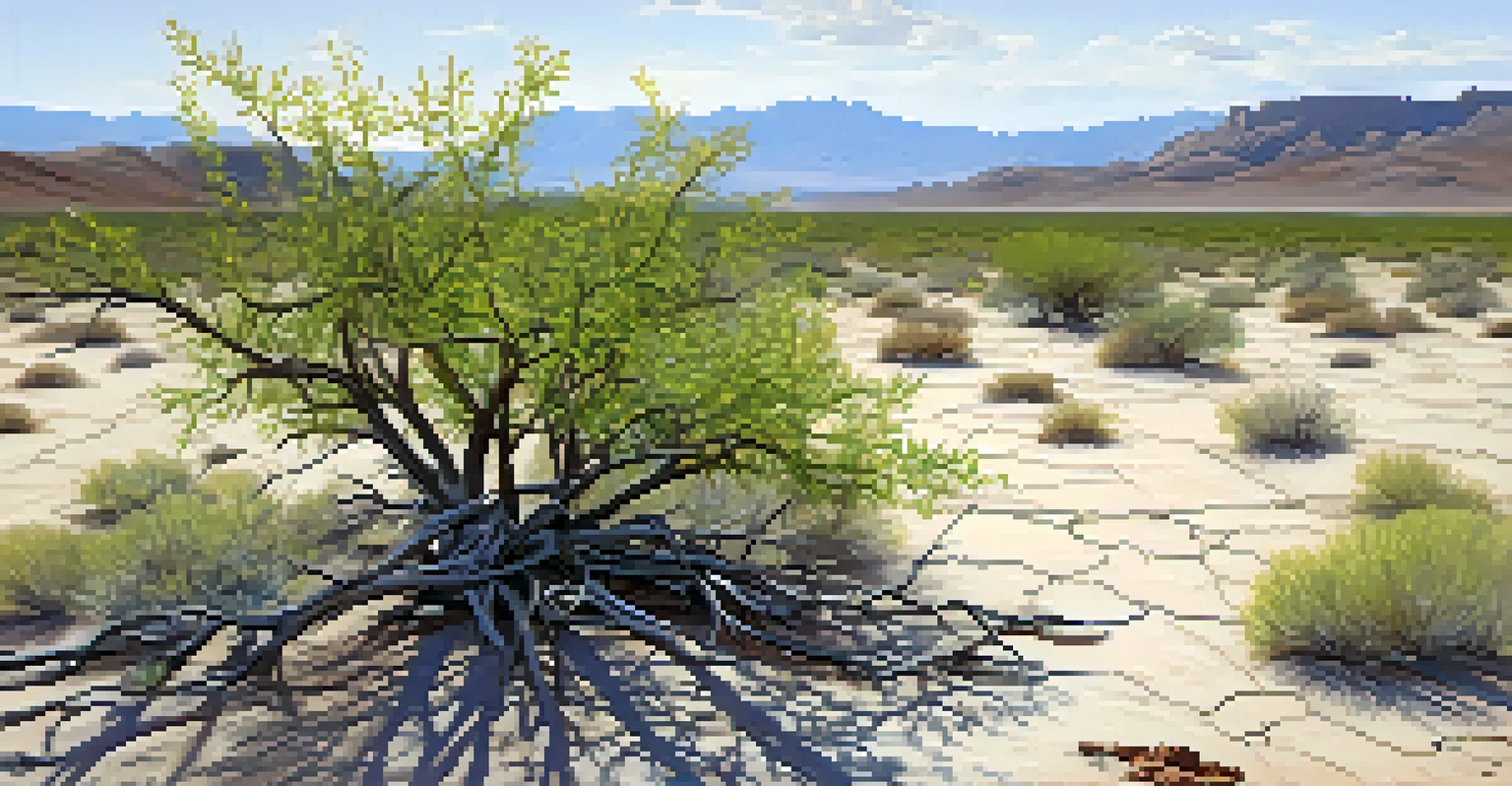The Role of Water in Nevada's Desert Ecosystems and Lifestyle

Understanding Nevada's Unique Desert Environment
Nevada is home to some of the most arid landscapes in the United States, characterized by vast deserts and mountainous regions. The state's climate is defined by extreme temperatures and minimal precipitation, creating a challenging environment for both wildlife and human inhabitants. Understanding this unique setting is crucial to appreciating the role of water within it.
Water is the most essential element of life, and without it, we cannot survive.
Despite the harsh conditions, life thrives in various forms, from resilient desert plants to diverse animal species. These organisms have adapted remarkably to their surroundings, showcasing nature's ability to overcome adversity. Water, in its various forms, plays a pivotal role in supporting this delicate balance.
Interestingly, the interplay between the sparse rainfall and the terrain creates unique microhabitats where water is more abundant, such as springs and streams. These pockets of moisture serve as critical lifelines for many species and illustrate how vital water is to sustaining life in Nevada's desert.
The Importance of Water for Desert Flora
In the arid landscapes of Nevada, plants have developed fascinating adaptations to survive with limited water resources. For example, the creosote bush can thrive in dry conditions, thanks to its waxy leaves that minimize water loss. These adaptations allow plants to withstand long periods without rain, showcasing the resilience of desert flora.

Moreover, water sources such as seasonal rivers or underground aquifers are essential for plant growth and reproduction. These sources not only provide necessary hydration but also foster biodiversity by supporting various plant communities. The presence of water enables the growth of lush vegetation in certain areas, creating oases amidst the desert.
Water is vital to desert ecosystems
Water plays a crucial role in sustaining both plant and animal life in Nevada's arid environment.
Ultimately, the survival of desert plants is a testament to the intricate relationship between water and life. Through their adaptations and reliance on water sources, these plants contribute to the overall health of the ecosystem, proving that even in the harshest conditions, life finds a way.
Water's Role in Supporting Desert Wildlife
Water is not just vital for plants; it is equally crucial for the wildlife that inhabits Nevada's deserts. Many animals, such as the desert tortoise and various bird species, depend on water sources for hydration and sustenance. These creatures have adapted behaviors to locate water, whether through migration patterns or foraging strategies.
The environment is where we all meet; where we all have a mutual interest; it is the one thing all of us share.
The limited availability of water forces wildlife to develop unique survival techniques, such as nocturnal activity to avoid the heat of the day. Some species have even evolved physiological traits that allow them to conserve water more effectively. This fascinating adaptation highlights the importance of water in shaping behavioral patterns in desert animals.
Furthermore, water sources act as gathering points for diverse species, fostering intricate food webs and interactions within the ecosystem. The presence of water can transform barren landscapes into bustling hubs of activity, illustrating how essential this resource is for maintaining biodiversity in Nevada’s desert.
Cultural Significance of Water in Nevada
Water holds immense cultural importance for the communities living in Nevada's desert regions. Indigenous tribes, for instance, have historically viewed water as a sacred resource, essential for life and cultural practices. Their traditional knowledge encompasses sustainable water management practices that have been passed down through generations.
In modern times, water continues to shape the lifestyle and economy of Nevada's residents. From agriculture to recreational activities, access to water influences various aspects of daily life. Cities like Las Vegas rely heavily on water management systems to support their growing populations and tourism industries.
Cultural significance of water
Water is deeply embedded in the cultural practices and livelihoods of Nevada's communities, particularly among Indigenous tribes.
Moreover, the historical significance of water can be seen in the development of early settlements in Nevada. Understanding this connection between water and culture allows us to appreciate how vital this resource is, not just for survival but for maintaining cultural heritage.
Water Management Challenges in Desert Regions
Water management in Nevada poses significant challenges due to the state's arid climate and growing population. As demand for water increases, competition for this limited resource intensifies among agricultural, industrial, and residential users. This situation necessitates efficient management practices to ensure sustainable use.
One of the most pressing issues is the over-extraction of groundwater, which can lead to depletion of aquifers. This not only affects water availability but also impacts ecosystems that rely on these underground water sources. Balancing human needs with environmental conservation is a complex task that requires careful planning and collaboration.
Additionally, climate change exacerbates these challenges by altering precipitation patterns and increasing evaporation rates. Addressing these issues requires innovative solutions and a collective commitment to sustainable water practices, ensuring that both people and ecosystems can thrive in Nevada's desert.
Innovations in Water Conservation Practices
Innovative water conservation practices are essential for adapting to the challenges posed by Nevada's desert environment. Techniques such as rainwater harvesting and xeriscaping have gained popularity among residents and businesses alike. These methods allow for efficient water use while promoting sustainable landscaping practices.
Additionally, technology plays a crucial role in enhancing water management strategies. Smart irrigation systems, for example, utilize sensors to optimize watering schedules based on real-time weather data. This not only conserves water but also supports healthier plant growth, demonstrating how innovation can lead to sustainable solutions.
Challenges in water management
Nevada faces significant water management challenges due to increasing demand, climate change, and the need for sustainable practices.
Community involvement in conservation efforts is also vital. Educational programs and initiatives that encourage residents to adopt water-saving practices can significantly impact overall water usage. By fostering a culture of conservation, Nevada can work towards a more sustainable future, preserving its valuable water resources.
The Future of Water in Nevada's Desert Ecosystem
Looking ahead, the future of water in Nevada's desert ecosystem will depend on our collective efforts to manage this precious resource sustainably. As climate change continues to impact weather patterns, proactive measures will be essential to ensure water availability for both people and wildlife. Embracing adaptive management strategies will be crucial in navigating these challenges.
Collaboration among government agencies, local communities, and environmental organizations can lead to innovative solutions that promote sustainable water use. By working together, we can develop policies that protect water resources while supporting economic growth and ecological health. The importance of a united approach cannot be overstated.

Ultimately, the role of water in Nevada's desert ecosystems is multifaceted and interconnected. By prioritizing conservation and fostering a shared responsibility for this vital resource, we can ensure a healthier ecosystem for future generations, preserving the delicate balance between human life and the natural world.